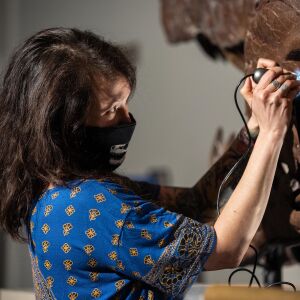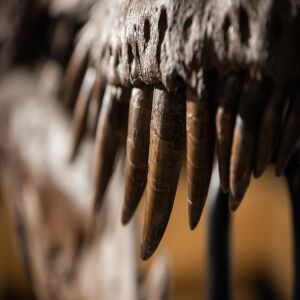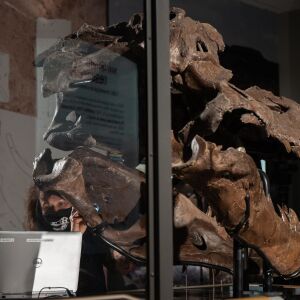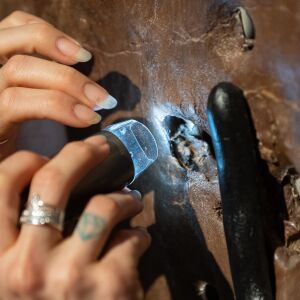About 67 million years ago, a brave — or possibly very stupid — dinosaur sank its teeth into Sue’s head.
That’s one theory about what left the pockmark-like holes — one as a big as a silver dollar — spread across the lower jaw of the Field Museum’s most famous resident.
Jingmai O’Connor, the Field’s new curator of fossil reptiles, isn’t sure she buys it.
“These patterns don’t match up with the teeth of other therapods,” O’Connor said.
Others have speculated the holes are the result of an infection.
In hopes of shedding light on a mystery that has baffled scientists for decades, Sue’s 5-foot-long, 600-pound skull was wheeled out of its glass case Wednesday. O’Connor, like a dentist with the most cooperative of patients, probed the indentations with a hand-held digital microscope — the first time the technology has been used on Sue, Field staff said.
Sue’s battered skull is full of holes — where muscles attach or where veins thread through. These holes are different. They aren’t found on every T. rex specimen, although they are common.
“So whatever caused it is something that is not unusual in the everyday life of tyrannosaurus. It’s something that they must have been commonly afflicted with,” O’Connor said.
O’Connor said there is evidence of bone that had grown back to fill in the holes. She hopes magnified images of the re-growth will offer vital clues.
Scientists often seek answers to such questions in the behavior of living animals.
“A big problem facing the Tasmanian Devils today is that they bite each other in the face and they gave each other a contagious cancer. How terrifying is that?” O’Connor said. “It’s actually caused a huge problem in decline in their population.”
Perhaps the T. rex behaved similarly, O’Connor suggested.
“It’s possible the T. rex were biting each other in the face and giving each other this ... infection. ... It also could come from infected prey,” she said.
O’Connor isn’t expecting a definitive answer anytime soon — even with the new technology.
“We’re dealing with such fragmentary, limited information,” she said. “All we have is this fossilized skeleton. It’s not even the original bone. We are missing all the soft tissue. This is just one more piece of evidence that is going to help us shed just a little bit more light on this mystery.”


















